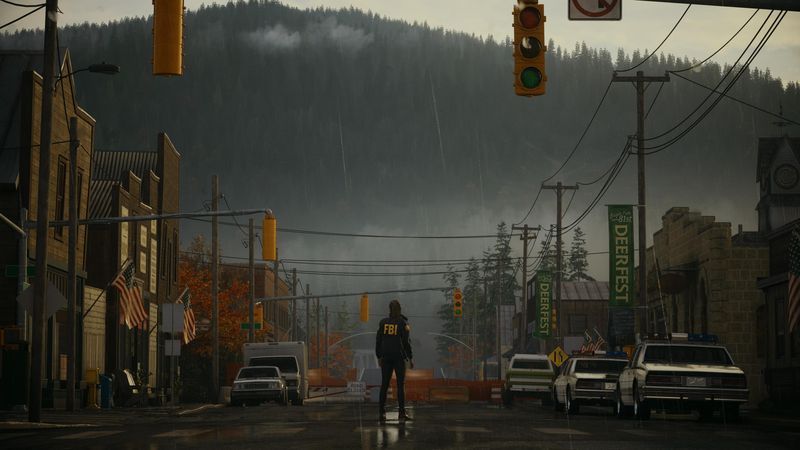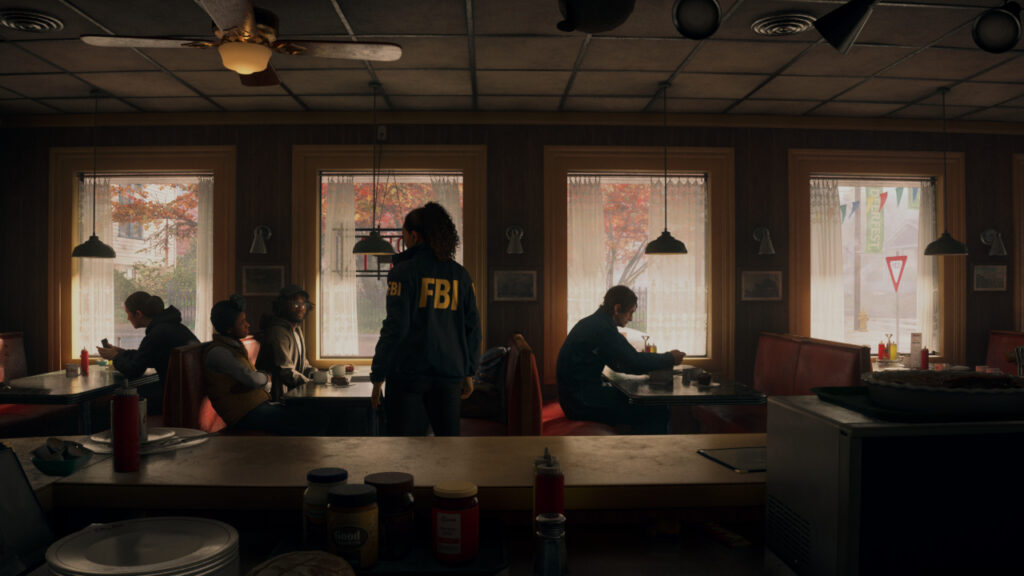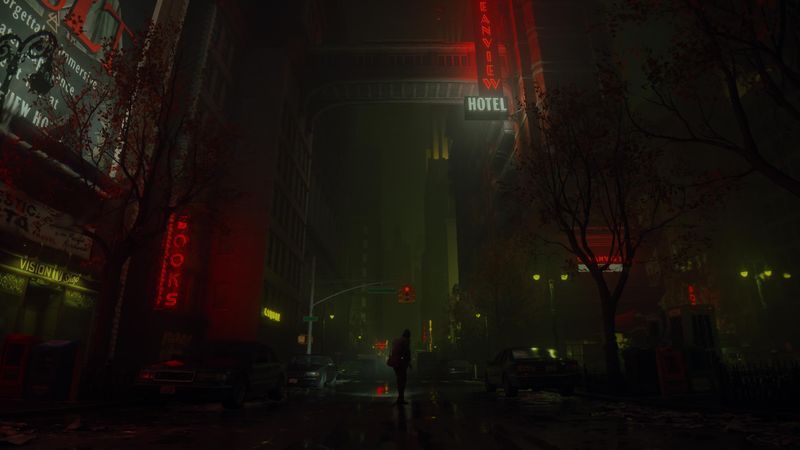After thirteen years, Alan Wake is back. Where he has been, all this while, is open for debate.
We left him, toward the close of the first game, at the bottom of a lake – although his final words were, “It’s not a lake. It’s an ocean.” This was likely in reference to the fact that, while he had appeared to sink merely into a body of water, he was actually imprisoned within a body of work. Alan was a writer by trade, and he was forced to go on writing, trapped in a realm of unending torment by a malevolent entity, which fed on Alan’s talent. It can’t have been much of a meal. Alan’s prose was lifeless but notable for its knack of coming to life; his bad ideas broke free of the page and groped their way into reality, clothed in a hundred horror-movie clichés.
They wielded axes and lumbered through dark and stormy nights, best dealt with by first shining a torch on them and then shooting them in the head. It was a great mechanic, with its blend of the homemade and the homicidal; it was part way between Resident Evil 4 and Ghostbusters, the beam of burning light and the over-the-shoulder shotgun. No wonder, in Alan Wake 2, we see our man, having washed up on a muddy shore, reaching for the tools of this trade. “A gun and a flashlight,” he says. “How nostalgic.” There is an echo here of Danny Torrance in Doctor Sleep, returning to the Overlook Hotel, roaming its corridors and saying, “Wakey, wakey.” Both men are racked by trauma, both are revisiting the places where their lives turned grim, and in both you sense a longing, layered with bitter irony, to relive old pains.

As was the case in that film, the game is woken up not by haggard old heroes but by fresh faces. Danny was pulled out of his misery by Abra, a bright girl who was tethered to him by psychic power. Alan is pulled out of his misery by Saga, a bright F.B.I. agent who is tethered to him by psychic power. I have to say, Saga is at times a little too bright, given the surrounding murk. “I’m thrilled to be here for this mystery,” she says, after being called to investigate a former colleague’s murder. She sounds less like an agent of the bureau than like an eager fan, giddy at the prospect of being invited into the fiction. The poor guy, we learn, had his heart cut out by masked maniacs, and what is Saga’s reaction? “It’s my first cult case! Exciting!”
If that sounds like a wrong note, no matter. The director and lead writer, Sam Lake, is smart enough to know that if you string enough wrong notes together, you can still make sweet music. Take Saga’s partner, Alex Casey, who just so happens to share his name with the star of Alan Wake’s pulpy books. It sounds like a joke, and we hear that Casey is indeed teased for it back at the office, but later on he gets a chance to interrogate Wake – whose writing has been linked to the murder – and reveals an uncannier connection. “There are echoes to my life in there that make it feel like someone’s been watching me,” he says, of Alan’s potboilers. And so the falseness seeps through the fabric of the game; you wonder if the characters have been cooked up by Wake, their entire lives boiling in his pot.

Alan Wake 2 is one of those serious sequels that try to expound on the ideas of the original and wind up looking lopsided. When Naughty Dog made Uncharted 4: A Thief’s End, it felt as if it were trying to excavate its hero’s hidden depths; only, the brilliant thing about him was that, over the course of three main entries, he didn’t have any. It told you more about Naughty Dog – about its desire to dig around in search of weight, its willingness to plant treasure on the way down and pretend to lever it loose. The developer here, Remedy Entertainment, has plucked Alan from his inky purgatory, buying the rights to the intellectual property back from Microsoft, but a lot has changed since 2010.
The coup of the first game was that it felt like the sort of thing Alan himself would publish: coarsely textured but hardbacked, as it were, bound in lavish graphics and light on real heft. What’s more, as befit its theme, spooky life sprang from blocked art; Remedy had tried for years to make an open-world game, pared back the ambition, but kept the sprawling environments. You poked around the town of Bright Falls, Washington, and the place felt haunted by dead possibility. It was all curbed freedom and tranquil stagnation. The ocean had shrunk into a lake.
The new game, by contrast, has the odour of prestige about it. The characters go right on talking nonsense, but the tone is now that of solemn drama, caked in American gothic. I kept my fingers crossed for Barry Wheeler, Wake’s agent, to skid into town; he turned up in Bright Falls last time round and brought a welcome dab of city slickness to the proceedings, along with a crackle of comedy. No such luck. He has been barred from the sequel, presumably for fear that he would snap its gloomy spell. Mechanically, too, Remedy has tightened the screws, billing Alan Wake 2 as its first survival horror. This means sparser ammunition, and the camera has been yanked in close. It used to hang back in airy long shot, a holdover from the Max Payne days, and it was a good jibe. It birled around Alan and shamed him: the elbow patches, the bungled leaps, the sprint that slackened into a panting jog. He was a nerd, at home behind a desk, being ground through the action mill.

Now the pace is more methodical. The characters fill the frame, and we loom near enough to inspect the soil-brown tweed of Alan’s sport coat, and the luminous yellow lettering of the “F.B.I.” on the back of Saga’s windbreaker. We switch between the two, collecting batteries, bullets, and puzzle pieces – a cluttering of Jungian symbols (keys, masks, a human heart) that pump the game with humming portent. I must admit, I preferred playing as Saga to playing as Alan. He spends most of the time in The Dark Place, which resembles a nightmare vision of New York, smothered in rubbish and viscous shadow. (I would wager that the developers enjoyed repeat screenings of both Taxi Driver and Angel Heart, with its rain-smeared New Orleans, while making this game.)
As moody as they are, Alan’s segments aren’t as interesting, by virtue of their being unmoored. “It wasn’t solid, it flowed. It was conceptual and subjective.” Such was his description of the metaphysical dungeon years ago, and the trouble is that, in narrative terms, you need the solid. Instead we get puzzles involving light switches and shifting environments. We get Alan reverting, again and again, to a dream of his apartment, in search of his lost wife, Alice. You get so conditioned to last-minute rug pulls that you lose the point; it’s easier to just sit on the rug and resign yourself to the ride. Remedy splices in strips of FMV, and we watch Ilkka Villi, as Alan, endure a late-night talk show whose host is too gnomic and nebulous to command any ratings. After an hour or two in the stagey fug of these chapters, you long for real airtime: the cold and brain-sharpening variety breathed by Saga, out in Washington.

Not that her passages, solid though they are, are free of the conceptual and subjective. After gathering evidence, she retreats to her “mind place”: a cosy wooden cabin in her head, with photos pinned to the wall and forming a web of thought. It’s a silly conceit, though oddly charming, and slotting evidence into place, as she monologues along, feels more like scrapbooking on holiday. It’s when Saga gets on the case that Alan Wake 2 comes alive. Bright Falls is still furred with pine trees and rolling fogs, and the nearby town of Watery earns its name, with an overrunning river and skies like wet cement. Remedy has colonised the hours of dusk, and you ought to play this game if only to admire its love of low light – the way it gathers in corners, and can be brushed into well-meaning towns and faces.
After the credits have rolled, it’s these images that stay with you, crying out from beneath the depths of Lake’s writing, and rising off it like steam. There are remarkably few concessions to newcomers here. If you lack a degree in Wakeology, you will have a tough time sifting through the plot. There are rewards for longtime lovers of Remedy, with light nods to Quantum Break and heavier nods to Control, which now officially shares the fiction. The most telling callback, however, comes in the middle. Lake provides the likeness for Alex Casey throughout, which feels like an unnecessary intrusion; but when we see Casey in that foul New York echo, in a leather jacket, with James McCaffrey’s voice growling from his mouth, we see why. It’s Max Payne, back in all but name, patrolling the same squalid patch where he first made his mark.

Lake lent his face to Max in 2001, pasting his permanent frown onto the hero, and we are supposed to read his appearance here, I guess, as a comment on the nature of writing, of sequel-making, and on the cycles of creative repetition that stamp an artist’s output. You will either find it refreshing to see a major developer, backed by Epic Games, attempt a similar feat to the one Kojima sneakily pulled off in Metal Gear Solid 2: Sons of Liberty, or else you will shrug and wonder when you can get back to shooting. The problem for me is similar to those times in Scream where you kept glimpsing Halloween on a TV in the background, and wished you were watching that instead. Listening to Casey’s voice-overs, you can’t help but be swept back to Max Payne 2: The Fall of Max Payne – still Remedy’s finest moment.
Lake wrote that game but didn’t direct it, and many of the same themes – doppelgangers, imaginary cities, self-annihilation – were present, but they festered wonderfully in the margins. Here they are the main event. Nonetheless, this is no reason to take against Alan Wake 2. Given the choice between a blockbuster weighed down by imagination and one completely without it, I know which I would choose. If you are a fan of Capcom’s Resident Evil remakes, and you pine for a Pacific Northwest-flavoured variant, this is for you. You may get more than you bargained for, and if you didn’t play the first outing then much will drift over your head, but you come away sated and wiped. Needless to say, nothing is resolved by the end, and we are sure to be in for another sequel. Here’s hoping that Lake heeds the advice of Odin Anderson, an old rocker, and one of Bright Falls’ more eccentric residents. His warning to Saga is as grave as it is hopeful: “Don’t be part of the story. Make the story.”
Game: Alan Wake 2
Platform: PC, PlayStation, Xbox
Developer: Remedy Entertainment
Publisher: Epic Games Publishing
Release Date: October 27, 2023






